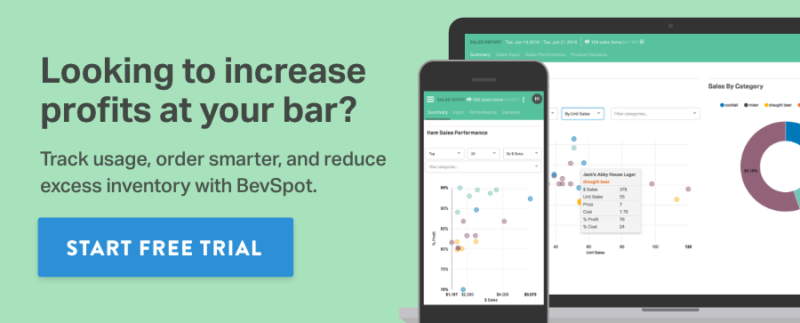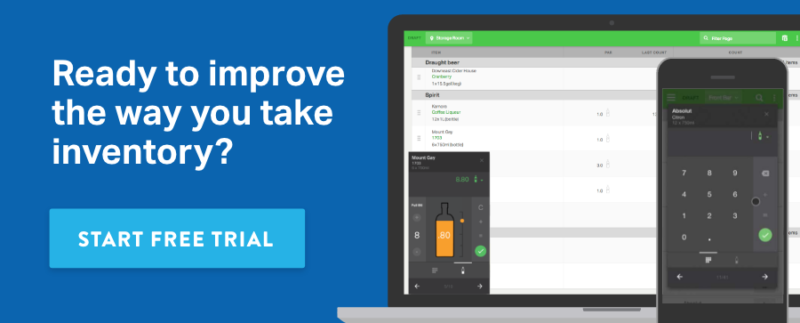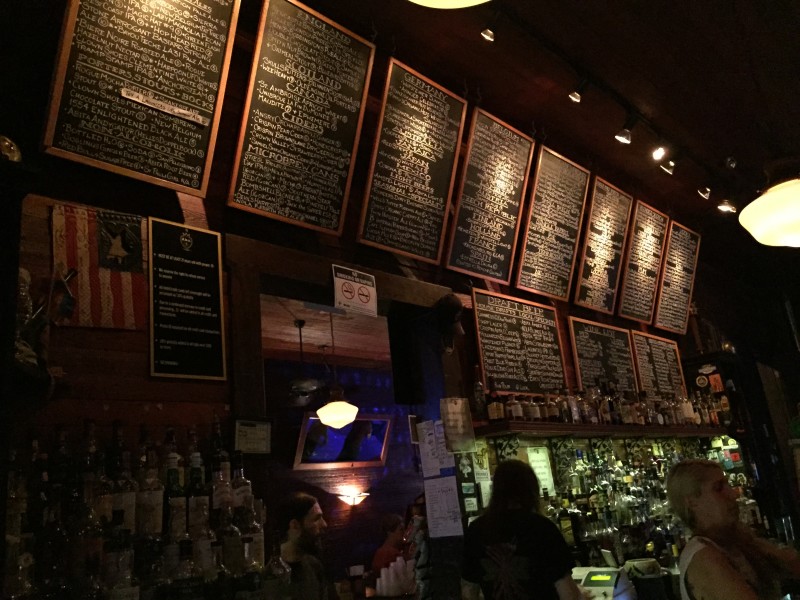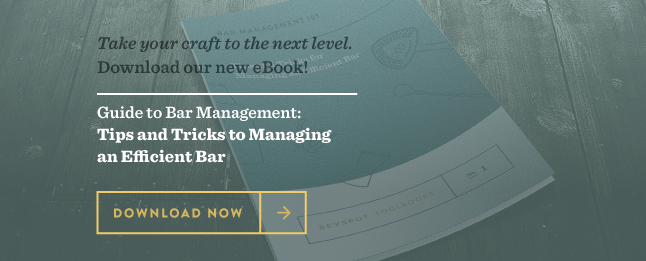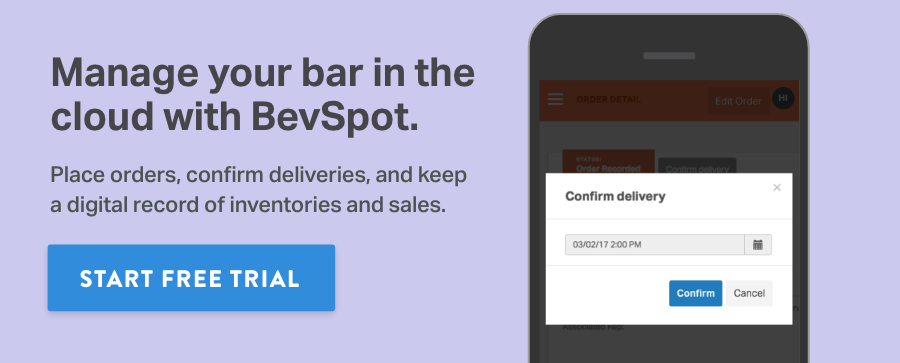A Day in the Restaurants of Portland, ME
Being in the restaurant industry, I had repeatedly heard about the magical land of Portland, a place filled with culinary and cocktail gems. But I had yet to experience it for myself until last spring, when my girlfriend and I decided it was time see with our own eyes if this mythical place really did exist, and could it really live up to its reputation?
We started early, ensuring that we could maximize the experience and hit as many restaurants as possible.
Our first stop: Duckfat. The wait averages about an hour and a half for lunch and doesn’t get any better for dinner. Truth be told, it’s worth at least three times the wait, and luckily there’s no lack for places to kill time while waiting for a table…
The Honey Paw
We stumbled on The Honey Paw, a noodle bar just up the street. Grabbing two seats at the bar we embarked on our day by turning to the bartender for recommendations. Turns out we had found the right guy, John Myers, Bar Manager for three restaurants on the block and a guy who really knows his stuff. We were in great hands. He recommended a Kolsch classic German Ale that was well-suited to my taste for crisper style beer. For my girlfriend, he made the Strong Paw—a perfectly balanced mezcal-based cocktail, both smokey and refreshing. With two perfect drinks in hand and great service, we almost forgot we were waiting for a table down the street.
And then it was time for lunch…
Duckfat
True to it’s name, Duckfat specializes in duck-featured dishes such as duck breast salads, duck confit paninis, and the epically delicious duck fat fries, best served in poutine form topped with duck fat gravy and perfectly half-melted cheese curds. And just when you think it can’t get any better, you taste the signature sea salted duck fat caramel milkshake, the best milkshake I’ve had to date.
Too early for a sweet tooth? There’s also a great selection of local beer on draught, and it’s never too early for that.
The adventure continued, and after many a colorful yarn store, Kombucha-filled markets, and handmade pottery galleries, we were ready for our next meal.
Central Provisions
We decided on Central Provisions for dinner for its seasonal menu focused on small plates and local produce. The menu covers all bases of seafood, meat, produce, raw, hot and everything in between. And the beverage program is no different with a solid wine selection, local beer, and innovative craft cocktails.
I opted for a cool spin on a classic with the Peaks Island Punch, a perfect combination of cognac, pineapple, and black tea. The food highlight was the roasted bone marrow, subtly browned to perfection with a spicy touch of horseradish.
Hunt and Alpine Club
Fighting off our fullness and not quite ready to head home, we made one final stop at Hunt and Alpine Club for a couple cocktails. The Bonecrusher is a smoky, spicy variation on a margarita, sure to give you a second wind. As a big fan of fizz cocktails myself, the Green Eyes hit the spot with its herbaceous and floral spin on a gin fizz, both creamy and refreshing.
Hard to believe we had room for a few more bites, but we couldn’t resist a couple snacks like the delicious green chili and butter popcorn and the brown bread with mushroom butter.
It only took a day to gain a full understanding of why Portland has the reputation it does; I was hooked. A small town on the water that takes just a bit of wandering around (and a little help from Yelp) to find so many culinary gems. I have no doubt that there are many more to be found, and I have every intention of doing just that in my future visits to Portland.
Crafting Cocktails: Paulo Pereira’s Mariana
Recipe
Mariana
Ingredients
- 5 lime wedges
- 1/2 oz Luxardo Mararschino
- 1/2 oz simple syrup
- 1 oz medium bodied red wine
- 3/4 oz St. George Spiced Pear
- 1 oz Leblon Cachaca
Instructions
- Muddle lime wedges.
- Add ice.
- Shake.
- Pour into glass.
About the Drink
“This variation came about when I was sitting with my parents and wife around a table outside one day. My father had heard of and sampled Caiparinhas with the addition of red wine from some of his Brazilian friends. After making us a round, my wife had the idea of adding the maraschino liqueur and after some experimenting the Mariana was born.”
How Tin Play Barware is Making Bars More Efficient
Flaws Behind The Bar
When Jeremy LeBlanc noticed just how many things can go wrong behind the bar, he set out to find a solution. Having a ton of experience behind many different bars, and years of training new bartenders under his belt, Jeremy, along with his business partner Chad Berkey, noticed that even the most talented bartenders were over-pouring and providing guests with inconsistent cocktails.
Truth be told, a lot of components go into each and every cocktail, and in a high volume bar with many eyes on the bartender at any given moment, balancing the precision of ingredients, along with the hospitable nature of the job, can bequite a difficult feat. “With 10 people watching you, you’re trying to be a good host, you’re trying to be a good bartender, pumping out cocktails left and right,” says LeBlanc. Factoring in that the average establishment loses 25-30% of inventory to waste, it becomes clear that the system is flawed.
 A New System of Bartending
A New System of Bartending
And so Jeremy and Chad sought out to fix this issue. “It was really about creating a system of bartending, but the idea grew. We took it a step further and made a prototype,” says LeBlanc. And thus Tin Play was born, a streamlined set of bartending tools strategically designed to fix the exact issues that go on behind any bar.
There are many factors that go into the efficiency of these bar tools. First and foremost, consistency, “we wanted to make cocktails more efficient, putting out consistent cocktails everything single time,” says LeBlanc. Using Tin Play’s patented ‘high speed reference line’ which is a metal pin centered inside of the 32 oz. Precision Pour Shaker Tin, a bartender can simply scoop ice to the top of the pin, add liquid ingredients, “as soon as that liquid hits the top of the pin, it’s the perfect pour—perfect martini pour, perfect rocks pour—every time.”
Beyond efficiency, the shaker itself is designed to enhance showmanship through its design. Tin Play’s shakers are clear with stainless rims on the bottom and top for an aesthetic ode to the old-school shakers. The goal here is to create an experience where customers get to watch the art of layering a cocktail. “It’s not just about being a great bartender but a great ‘showtender,’” says LeBlanc, “When you say the word ‘flair’ people think of throwing bottles up in the air and spinning them around, but it means a whole bunch of things. It’s about going the extra step, being all you can be behind the bar and creating that experience that goes from one person to the next so that people are telling others how they had a great time and felt involved in the process of making drinks and watching cocktails be made.”
There are other benefits to the transparent design, “you can’t see well into a traditional shaker, so a lot of waste can happen either in the alcohol itself or the mixers.” The bartender is able to easily visualize the precise pour, keeping consistency in the balance of cocktails. Managers can also keep an easy watch on their team to ensure that the liquid levels are going right up to the pin, eliminating over pour and even theft.
Beyond the Shaker
Tin Play quickly evolved beyond the shaker, next introducing its Ultimate Muddle Tool, a 4-in-1 tool (all Tin Play tools are multi-use)— a muddle, bottle opener, can opener, and jigger all in one sleek design. The jigger has a range from .25 oz to2 oz, and is again clear, ensuring efficient alcohol pours and keeping pour costs in mind.
Simply flip the jigger the other way and it becomes a muddling tool that envelopes the pin inside the shaker and has a jagged tooth edge for crushing and grinding fruits and herbs, and again, involving the patron to watch the process. The opposite end of the tool is a bottle opener and can opener, “the bottle opener has a half moon to open up cans so it doesn’t uproot your fingers, bringing bar rot down.”
The 16 oz. Cheater Tin, made of the same materials as the shaker, is another complementary component to the line, “when you scoop ice with it, it’s the exact amount of ice you want to use, putting all the ice to the top of the shaker’s pin.” Combine the Cheater Tin and shaker to create a strainer.
Heading to Market
After a full year of development and putting the line to the test, Tin Play took in some feedback to perfect the designs. Now with five patents on their products, a whole bunch of bars in San Diego using the tools, and a sales presence on Barproducts.com as well as Tinplay.com, Tin Play is ready to take on the market full force. “We’re forming strategic partners with wholesalers and distributors and gearing up for a busy 2016,” says LeBlanc, who sees endless possibilities for Tin Play.
Thanks for the chat, Jeremy! And looking forward to seeing you in March at the Nightclub and Bar Show.
Loco Taqueria & Oyster Bar Saves Over $26k Using BevSpot
Mike Shaw and Will Falaro, the respective co-owner and bar manager of Loco Taqueria & Oyster Bar, remember what life was like before BevSpot at their previous restaurant. As I sat with them at their bar reminiscing (err, commiserating) about the old days of 60-page, handwritten inventories, it was obvious that those days were—and will always be—behind them.
As we got deeper into it, they began to unearth the suppressed memories of pen-and-paper inventory: coming in on off-days, staying until 4:30 am, organizing every single liquor bottle in alphabetical order. Let’s just say terms like “archaic” and “nightmare” were used far more than “exciting” and “riveting.”
Instead of spending their time growing the business, it was spent in a basement huddled over a piece of paper trying to translate their own handwriting:
“Is that a seven or a four?”
But as they soon discovered, it didn’t have to be that way. The bar manager at Lincoln—the previous bar they worked with—had just adopted BevSpot, and the positive upswing in their beverage program (and morale) was immediate. When Will and Mike moved on to open Loco a few months later, the decision to implement BevSpot was an easy one.
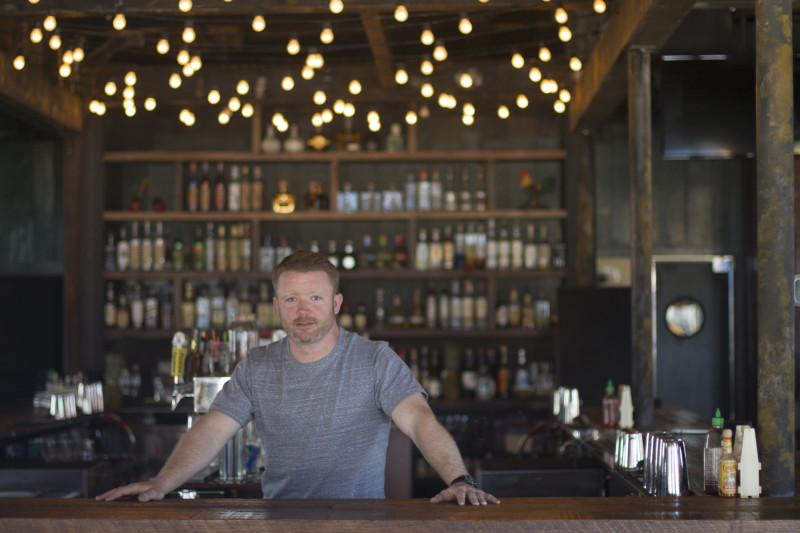
As Mike told me, “The decision here was 100% Will’s choice—it’s his beverage program. If he wanted to spend four hours on Mondays with 30 pages of Excel documents, God bless him. But he saw how easy life was over there at Lincoln.”
As it turns out, life is great at Loco as well. Since their first month, they’ve seen a 30% decrease in weekly ordering costs and have realized “$26,000 to $30,000 in cash savings.” And since they’ve cut their entire inventory process to 90 minutes, they can now dedicate that extra time to working on the cocktail list, finding great staff, making sure they have schedules done, and helping to build the business.
While it’s easy to just chum it up at the bar with Will and Mike, there’s no doubt that they take their restaurant—and bottomline—very seriously. Since they onboarded, they’ve been one of our most active customers, and the results have shown. Not only that, but they’ve helped us refine our product through constant feedback.
We can’t wait to see them continue to make their mark on the Boston dining scene — tacos, oysters and all.
See the Full Case Study Here
Schedule 15mins to chat with a product specialist
Start a FREE Trial Today! BevSpot offers full product education and account setup for all customers! No card Information needed!
BevSpot Engineering Spotlight
This piece was written for VentureFizz. To see the original post, visit the VentureFizz Blog.
What’s your engineering team’s background?
Despite serving the food and beverage industry, BevSpot is first-and-foremost a tech company, with a strong focus on delivering powerful software. Two of the company’s co-founders have computer science backgrounds from MIT—so we’ve had high expectations for our tech team from the beginning. And, our second full-time hire previously founded a design studio and taught interaction design, so we’re serious about investing in the user experience. Importantly, the team has a shared entrepreneurial ethos—everyone works to make a big impact on our business while ensuring that our products benefit our users in their day-to-day. It’s great that everyone likes to be out in the field learning from our customers—we know many of our customers by name, and have met with and tested the product with them, so we’re all personally invested in their success with our product.
Highlight a couple of people specifically.
Chidubem Ezeaka (Cheezy)
Cheezy – tell us a bit about your background:
I am a Co-founder and BevSpot’s Chief Product Officer. I grew up in Nigeria and was very interested in Math and Science from a young age, and even took part in a few national competitions during the time. I took AP computer science in high school, and my interest in programming grew from there because of its similarities with math.
I attended MIT where I double majored in Math and Computer Science as an undergrad, and then got my M.Eng in Computer Science. My concentration was in systems where I wrote my thesis “tournament based task allocation in parallel algorithms”. While at MIT, I worked at Amazon on their vendor ordering prediction systems and then at DRW trading on web tools to help traders visualize and perform analysis on historical market data.
Proud Engineering Moment?
In my last year at MIT, I took a popular project-based class, 6.172 (Performance Engineering of Software Systems) that focuses on building highly-performant and scalable software systems. It went through the basics of compiler optimizations, parallel programming and general techniques for improving run-times. For the final group project we were asked to performance-engineer a game engine that plays LeiserChess, a two-player game similar to Khet, and the course ends with a tournament where all the submissions play against each other in a round robin format. My team’s submission won, losing only one game in the process.
What do you like to do outside of your interests in technology?
I play a lot of soccer in my free time. While I was at MIT I played with the Grad soccer club team and since leaving school I still play a lot of pickup games on the MIT fields on the weekends and in the indoor IM leagues in the winter when it gets cold out. I’m not super into video games but I play a bit of FIFA, anyone is welcome to come challenge me at the BevSpot office.
I am also a big Arsenal fan. You can find me on some weekend mornings watching their Premier League games and enjoying a beer at one of our awesome Boston accounts.
What’s your favorite thing about bevspot?
I like how fast things move at BevSpot. There are exciting new challenges to overcome almost everyday on both the tech and the business sides. We work really hard to make BevSpot a successful company but we also like to have fun as a team.
Alex Lesman
Alex – tell us a bit about your background:
I did undergrad at MIT (with Cheezy) where I studied CS and MechE. I was pretty big on robots coming in so that’s how I ended up with that combination, but I found CS classes more compelling. I was very fortunate with my internships, I spent a summer at Facebook on the site perf team (where I got hooked on Vim, check out my vimrc) and a summer at Formlabs working on the beta model of their Form1 3D Printer. The last thing I did before BevSpot was a 4 month stint on the IHMC DARPA Robotics team where we worked with a 6’ humanoid robot called ATLAS (here’s a video of the kinds of things we were doing). I had the chance to see big-company, early start-up and academic environments then, and now I get to enjoy the start-up environment again at BevSpot.
Do you have a proud engineering moment?
My senior year I took a robotics competition course at MIT that takes place over the January term called MASLAB. Teams of three to five (shoutout to my teammates Jorge Perez and John Bowler) work to build an autonomous robot in four weeks to accomplish a set of tasks, and It’s generally considered one of the most difficult competitions courses. I was really impressed with what we were able to get done in those four weeks, and we won the competition that year. Since then we’ve all come back to teach the course which has been a lot of fun as well.
What do you like to do outside of your interests in technology?
I really enjoy building things, I do all my own bike maintenance and had a great time over the last few weekends building a bar at our new office. Some friends and I have started a tradition of building a boat to take out on the Charles for the 4th of July. It’s evolved and grown over the years, this last year it was 48 feet long and carried a crew of 40. If you’re in Boston for the 4th and you see a 48 foot canoe taking on water as an inept crew paddles it clumsily down the Charles…odds are I’m involved.
What’s your favorite thing about bevspot?
I really enjoy building something that is honestly valuable to people, and we have great customers who we can really help with our software. And, in addition to giving us great testimonials (see bevspot.com) they also make great drinks.
Plus, the team at BevSpot is incredible, and we all share a commitment to building a really talented team across the organization. On the engineering side I think everyone who’s joined has been a perfect fit—it’s a lot of work to find the right people, but we all agree it’s worth it. One of my favorite BevSpot stories is from early on when we were looking for a “Designer/Developer” unicorn. We looked at hundreds of people and gave everyone a score from 1 to 5… except one person who we gave a 6. Now Alex Turnwall’s been with us since January (though it feels like much longer than that) and it’s hard to imagine BevSpot without him.
What is your tech stack?
On the server we’re running Django backed by PostgreSQL, MongoDB, and ElasticSearc. We’re using the Jinja2 templating engine instead of Django’s for performance reasons, but we’re also much happier with Jinja’s macro and function structures. On the client side we have a straightforward HTML/CSS/JS and JQuery operation going. Mixed in with that we now have some JS libraries like D3.js for charting, but we’ve kept it pretty lightweight. We deliberately chose to start with a simple stack that formed a clean and flexible base. As our product grows and we continue to understand the challenges we face in building it, the architecture will definitely adapt to our requirements. In the relatively near-term we’re definitely looking at incorporating a client-side framework. In the long term the ‘monolith vs. microservices’ debate will be an ongoing discussion. Not that they’re mutually exclusive, but deciding where in a monolith there’s a natural ‘seam’ along which to carve out a microservice is not always easy.
What are some of the cool / interesting problems that you’re solving?
In many aspects of our product there is a big challenge to create a product that sticks really closely to our users’ existing workflows and their existing understanding of how bar processes work while taking away a lot of the work and providing more powerful insights they wouldn’t ordinarily be able to reach. What this means is that we always want our application to be easy to use/understand while being really flexible and customizable to the user’s needs without overwhelming with options/functionality. So it is a tough challenge to provide really complex functionality that is still easy to use and understand. We solve real life challenges that are impactful on our customers’ daily lives. And we meet our customers face-to-face and see their appreciation on a regular basis. We create a real tangible value for people.
We create flexible data-models, workflows and interfaces without compromising efficiency or learnability. And, at the end of the day, we can go to a bar and get a free drink from the bartender, who’s incredibly happy that he wasn’t up until 8am doing inventory because he’s using BevSpot.
Another unique thing about BevSpot is that our entire application is fully responsive. This doesn’t mean that some things move around and you can do most things on your phone with some functionality hidden. Users can really do every single thing on their phones, and absolutely no functionality is lost going from your laptop to your phone or other device.
There are new challenges everyday here. Whether it’s a customer needing to use the product in the bar’s basement with no internet, or a large restaurant needing to see 1000+ inventory products in an easily viewable and maniputable way without slowing down the web page, the team creates the functionality to make it work. And what’s really exciting is that over time, we will have real data on consumer trends and the analytics to have an even heavier impact on our clients’ efficiency and profitability. In the not so distant future, we will be processing billions of dollars worth of transactions in the bar and restaurant industry.
What is the culture of the engineering team?
Everyone cares passionately about delivering the best products. We’re very close to our customers and always try to keep them in mind in our decision making. We also always want to move as fast as possible while keeping balance with getting things done right.
It’s a complete open floor here and we have very honest debates constantly; everybody’s opinion matters. We do not operate on a silo mentality and try to encourage everyone to learn about technical areas outside of their particular expertise. No one is pigeonholed at BevSpot. Everybody has an opportunity to contribute at every level of the code base.
The whole “work hard, play hard” aspect is a bit of a cliche in the startup world, but it’s very true on our team. We work very hard, and it pays off. So, we celebrate…a lot. Everytime we hit revenue goals, or pass milestones in inventory management dollars, we pop champagne and celebrate as a team, because we deserve it. Not to mention the fact that we work with some of Boston’s coolest restaurants and bars, so obviously we have to support these customers….by drinking at their bars.
Bar and Restaurant Inventory Management: Calculating Variance
Calculating Variance
Product variance, otherwise known as loss or shrinkage, is one of the biggest detractors from a beverage program’s profitability. It represents the difference between the amount of product sold over a given period of time, and the amount of product used over that same period. In an ideal world, these numbers would line up perfectly, but as we know, that isn’t the case in the industry.
Variance can be calculated as:
$ Variance = [$ Cost of Product Sold] – [$ Usage]
or
% Variance = [$ Variance] / [$ Usage]
Understanding and minimizing variance is critical to running a successful beverage program.
Step One: Calculate Usage
You can’t calculate variance without first calculating usage, which is your starting inventory minus your ending inventory (adding in any received inventory from the usage period). This number shows you the total amount of product used during a specific period of time.
Step Two: Calculate Cost of Product Sold
Knowing your usage, you can now compare this information to your sales data to find out the amount of product that was actually sold over the same period. In order to calculate the cost of product sold, you’ll first need to calculate your pour costs.
-BevSpot Bourbon costs $18.00
-Each bottle of BevSpot Bourbon gets 10 pours
-$18.00/10 pours = $1.80 Pour Cost
If a bar sells 20 pours of BevSpot Bourbon over the usage period, the cost of product sold on the bourbon would be $36.00 ($1.80 x 20 pours).
Utilizing your Point of Sale System to run a Product Mix report (or PMIX report) will show you every product that was sold during a given period of time. Using the PMIX report, multiply the quantity sold of every individual product by its pour cost to calculate the total cost of product sold during the period.
Step Three: Calculate Variance
Now that you have both your usage and cost of product sold, you are ready to calculate variance using the formula above.
Over a one-week period, BevSpot Bar’s usage was $10,000 and its total cost of product sold was $8,000.
$8,000 – $10,000 = -$2,000 variance
or
-$2000/$10,000 = -20% variance
These calculations show that BevSpot Bar lost 20% of its product before having the chance to sell it, drastically reducing the bar’s profits.
Knowing this number will help to identify and address potential issues with mis-counting, over pouring, theft, or other drivers of variance.
Learn more about our food inventory app or schedule time to chat with one of our product specialist.
Schedule 15mins to chat with a product specialist
Start a FREE Trial Today! BevSpot offers full product education and account setup for all customers! No card Information needed!
New Orleans: A Day In The Life of a Beer-Loving Tourist
Behind the colorful beads, the hangover-inducing Hurricanes at Pat O’Briens, and the bartop dancing at Coyote Ugly is a city still recovering from one of the worst natural disasters in history. Now, 10 years removed from the devastation of Hurricane Katrina, New Orleans is still discovering itself. Having been there three times over the past eight years, I’ve gotten to see the many different faces of NOLA.
While I could probably write ten pages on the music, cocktails and food, I’m going to keep this one simple: bars and beers. Imagine waking up around 11am on a Saturday after a late night on Bourbon St. This is what your day should look like. Trust me.
Dis & Dem
Once you manage to get your bearings, you’re going to want to make your way to Dis & Dem, a local burger joint with all the New Orleans fixins you’d expect. If you know what’s best for you, you’ll get a NOLA Blonde and the Dis & Dem Burger, which is their original burger topped with a hot sausage patty and “cheez.” N’awlins much?
Beer:
NOLA Blonde Ale
Style: American Blonde Ale
Brewery: NOLA Brewing Co.
Location: New Orleans, LA
ABV: 5.0%
What they say: “The perfect beer for all four seasons, especially crawfish.”
At this point you’re probably questioning your decision to get the Dis & Dem burger over a more health-conscious salad or something. But then you remember you took my advice. Oh, and you also remember that in the local tongue, “salad” is a bad word.
Lucy’s Retired Surfers Bar
By the time you’ve made your way down Canal St. on the streetcar (don’t call it a trolley) to the revitalized Warehouse District, you’ll feel refreshed and ready to get another drink. Lucy’s is a festive, easy-going hangout with a drink list to match. If you really want to look like a tourist, get the Shark Attack. But if you want to make a more reasonable decision, grab a seat outside on the patio and people watch over a refreshing Purple Haze.
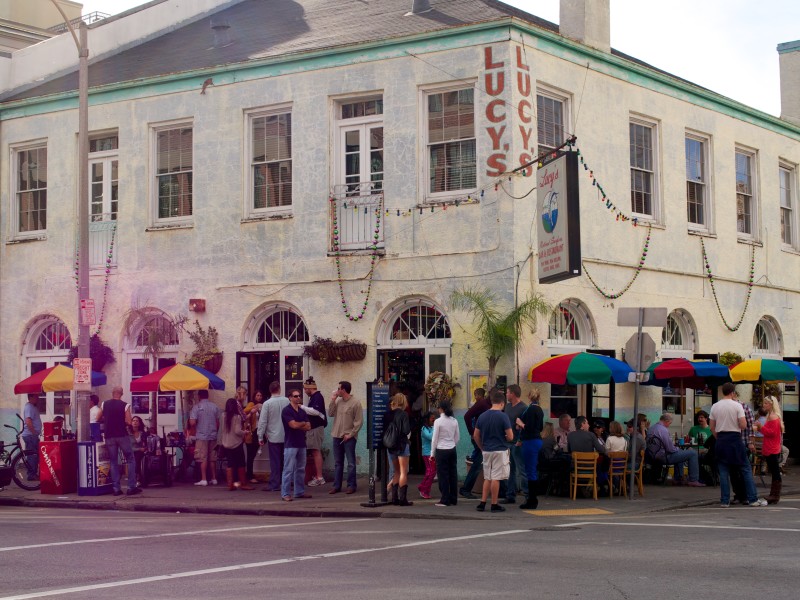
Beer:
Abita Purple Haze
Style: Raspberry Lager
Brewery: Abita Brewing Co.
Location: Abita Springs, LA
ABV: 4.2%
What they say: “Consider enjoying Purple Haze alone at the end of your meal as dessert.”
Down the Hatch
A 20-minute stroll down Magazine St. will bring you to an unassuming, slightly divey, slightly Irish bar in the Lower Garden District called Down the Hatch. If you’re like me, things are starting to feel like home here. Act like you stumbled upon the place, make good friends with the bartender, and in true local New Orleans fashion, order a $5 pitcher of PBR (assuming you’re with another person…or not).
But in the spirit of discovering new beers, you should also test out the ubiquitous and very tasty Amber lager, Abita’s flagship brew.
Beer:
Abita Amber
Style: Munich-style Lager
Brewery: Abita Brewing Co.
Location: Abita Springs, LA
ABV: 4.5%
What they say: “Amber is Abita’s most versatile beer for pairing with food.”
Carrollton Station
At this point, you’ll probably want to jump on the St. Charles streetcar, the oldest and most scenic of all the lines. You’ll be graced with beautiful views of Audubon Park, Tulane University and some of New Orleans’ most historic mansions. If the ride alone wasn’t worth it, you’re in for a treat at Carrollton Station, consistently voted one of the best music venues in the city. Oh, and they also have a killer beer selection. I’d suggest grabbing a 12 oz. can of Jack the Sipper while you watch some of the best local talent bring their best to the stage.
Beer:
Jack the Sipper
Style: ESB Ale
Brewery: Southern Prohibition Brewing
Location: Hattiesburg, MS
ABV: 5.3%
What they say: “Allows the victim to sip on multiple pints for a true UK experience down South.”
d.b.a.
A Saturday in NOLA is not complete before making your way to Frenchmen St. While some locals say it gets more touristy every year, it’s still the best place to see authentic New Orleans music. And no better place to witness that than at d.b.a. I’m still not sure what d.b.a. stands for, but if I had to guess, it’d be Drink Beer Always…because they have enough beer on their menu to drink beer always.
The beer list (see above) can be a bit overwhelming at first, so if you’re not sure where to start, try out the local LA 31 Bière Pâle, a drinkable pale ale with just enough spunk to make you get out on the dance floor.
Beer:
LA 31 Bière Pâle
Style: Pale Ale
Brewery: Bayou Teche Brewing
Location: Arnaudville, LA
ABV: 5.7%
What they say: “This beer is crafted to enhance the unique cuisine and lifestyle of South Louisiana.”
A Constant Evolution
New Orleans has certainly changed over the past ten years. The neighborhoods, the people, and the music are constantly evolving. While some of it has received justified resistance by the residents who grew up in “old” New Orleans, there’s no doubt that it’s still one of the most special places on earth, and it just happens to be right here in the US of A.
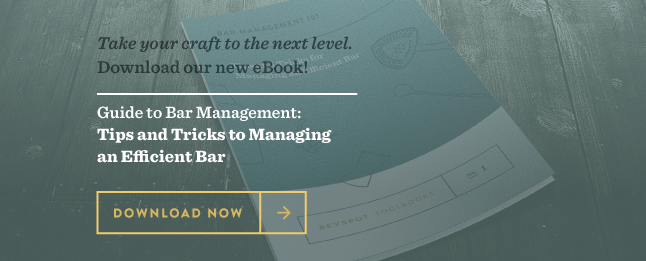
Tips and Tricks for Managing an Efficient Bar: Guide to Bar Management
We’re excited to announce the first in our series of BevSpot Tool-books: Tips and Tricks for Managing an Efficient Bar.
In talking to some of the industry experts on our team, and our amazing clients, we learned that there is a real knowledge gap in the world of bar management. It’s time to fix that with these insider tips and tricks.
Are you correctly calculating inventory usage reports and using these numbers to make better decisions for your bar? Do you order to reduce sitting inventory?
As obvious as many of these principles may seem, you’d be surprised at how often mistakes are made. Download this ebook to learn the formulas, principles, and tricks that will take your bar or restaurant to the next step in optimal inventory and Managing an Efficient Bar.
Schedule 15mins to chat with a product specialist
Start a FREE Trial Today! BevSpot offers full product education and account setup for all customers! No card Information needed!
The Story of How BevSpot Started
This piece was written for HourlyNerd. To see the original post, visit the HourlyNerd Blog.
One of the best pieces of advice I got when first starting BevSpot was “to constantly make progress, every day.” Now 18 months and 30 employees later, I still fall back on this advice daily. One of the best examples of how this advice served me is the story of meeting my two co-founders, Chidubem Ezeaka (who goes by “Cheezy”) and Alex Lesman.
Building a Tech Company
Before meeting Cheezy and Alex, I was just another wannabe entrepreneur with nothing but a good idea and the strong desire to see it through. Unfortunately, that was all I had. Building a true technology company takes great engineers, which are incredibly hard to find. An idea alone, even if it is a great one, has no real traction on its own, making it is extremely difficult to find talented people to take a meeting, let alone consider working with you. Incorporate the fact that most MIT engineers are inundated by business-school students looking for “coders” to build their products, and the odds of success fall to almost none.
The Basement of Harvard – Learning to Code
BevSpot was just a myth—an idea that I had no ability to build myself, and no partners with which to work on it. I was stuck. This is when I fell back on the advice. If I was to make progress every day, surely I couldn’t just wait around for something that might never happen. It was then that I decided to take action myself and commit the next couple weeks to building a working prototype on my own. After an intensive weekend course, ~150 hours in the basement of Harvard Business School’s Baker Library taking online classes and tutorials, and two weeks of teaching myself how to code, I created a very basic, and pretty terrible prototype of BevSpot.
This was an incredibly valuable experience for me. Not only did it give me a real appreciation for how hard building web applications really is, but it also made it very clear that on my own, I was never going to build anything that people actually used. Learning these two things ultimately led me to meet my co-founders.
Building the BevSpot Team
That week I upgraded to LinkedIn Premium and sent out 30 messages mentioning my prototype to MIT students with top-tier technology internship experience. One of these people was Cheezy, who to this day tells me that the only reason he responded at all was because I had taken the time to build a prototype. This was the primary separating factor I had over all the other inbounds he had received, and to Cheezy, it demonstrated that I was serious.
Within a couple weeks, Cheezy looped in his friend Alex and the three of us officially started BevSpot. Connecting with world-class business partners was the single best event that ever happened for BevSpot, as none of the company’s success to-date would be possible without Cheezy and Alex.
I will likely never write a single line of code again, and that’s certainly for the best. But looking back on the advice I was given, I take pride in knowing that I took control over making my own progress. It wasn’t about skills, it was about drive, and that is what ultimately led to the three of us starting BevSpot. Now as a company, we encounter similarly insurmountable challenges daily, and we always approach them in the same manner—seeking to understand exactly what we can control, and how we can continue to make progress every single day.
Crafting Cocktails: Ryan Lotz’s Manhattan
Recipe
Manhattan
Ingredients
- 3 dashes angostura bitters
- 3/4 oz Carpano Antica sweet vermouth
- 2 3/4 oz rye whiskey
Instructions
- Stir.
- Garnish with a cherry.
- Pour into chilled cocktail glass.
About the Drink
Ryan makes a classic Manhattan to demonstrate a stirred drink. He keeps this one pretty standard, because why mess with perfection?
Crafting Cocktails: Ryan Lotz’s Civetta Magra
Recipe
Civetta Magra
Ingredients
- 2 dashes Angostura bitters
- 1/2 oz agave syrup
- 1/2 oz lime juice
- 2 1/2 oz Pueblo Veijo tequila
Directions
- Shake.
- Strain into chilled cocktail glass.
About the Drink
A margarita variation, the name is Italian for the “Skinny Owl.” “It’s a bit of an inside joke…another bartender here used to make margaritas with agave nectar instead of orange liqueur which is a little sweeter. When she left, I wanted to put a cocktail on the list for her. We used to take Italian classes together, and she used to wear a lot of owl jewelry for her sorority. Our Italian teacher used to yell at her because in Italian ‘una civetta’ is a lady of the night.”
Crafting Cocktails: Ryan Lotz’s Ramos Gin Fizz
Recipe
Ramos Gin Fizz
Ingredients
- 1 egg white
- 1/2 oz lemon juice
- 1/2 oz lime juice
- 1 oz simple syrup
- 1 oz Beefeater gin
- 3 drops orange blossom water
- 2 oz heavy cream
- 1 oz soda water
Directions
- Shake all ingredients, except heavy cream and soda water.
- Shake with one ice cube
- Add heavy cream
- Strain into cocktail glass
- Add soda water
- Let settle for 1 minute
- Top with soda water
- Garnish with orange twist
About the Drink
Although it’s notoriously a tedious drink to make, Don Lee, a bartender at PDT, created a more efficient method. Ryan explains,”You shake it with one cube of really nice ice instead of shaking it for 20 minutes, and then just add more soda water than you typically would, which actually ends up with a much nicer texture.”
Crafting Cocktails: Ryan Lotz’s Bene and the Jets
Recipe
Bene and the Jets
Ingredients
- 3 dash Angostura bitters
- 1 dash absinthe
- 1/2 oz lime juice
- 1/2 oz grapefruit juice
- 1/2 oz demerara syrup
- 1/2 oz Benedictine
- 1 oz Pierre Ferrand 1840 cognac
- 1 oz Smith & Cross Jamaican rum
Directions
- Shake with one ice cube.
- Pour into tiki mug and top with crushed ice.
- Garnish with mint, a cherry, and a paper umbrella.
About the Drink
This is a variation on a classic tiki cocktail called a Jet Pilot. It’s not a serious cocktail, it’s about fun. “These are complex and really tough drinks to make; there’s a lot of ingredients, layering all those ingredients together can be difficult…there’s a lot of room for error, but there’s also a lot of room for cocktails that really sing…I’ve never put that drink in front of a person who didn’t smile and take a picture of it.”
Crafting Cocktails: Ryan Lotz’s House Old Fashioned
Recipe
House Old Fashioned
Ingredients
- 3 dash Angostura Bitters
- 3 dash Orange bitters
- 1/4 oz Demerara syrup
- 1 1/2 oz Paul Beau V.S. cognac
- 1 1/2 oz Privateer Amber Rum
Directions
- Combine all ingredients, stir over block ice.
- Garnish with orange and lemon twists.
About the Drink
Old Fashioned cocktails are typically made with whiskey or brandy. No. 9 Park’s Old Fashioned uses the cognac variety of brandy for a smooth finish.
Crafting Cocktails: Ryan Lotz’s Daiquiri
Recipe
Daiquiri
Ingredients
- 3/4 oz lime juice
- 3/4 oz simple syrup
- 2 oz Privateer Silver Rum
Directions
- Shake
- Strain into cocktail glass
About the Drink
“You talk to any chef and they’ll say ‘make an omelette,’ You talk to any bartender and they’ll say make a daiquiri,'” says Ryan of his favorite drink to make. The simple cocktail is all about the perfect balance of 3 ingredients.
The Past and Future of GrandTen Distillery
Inside the Foundry
Although it has occupied its former foundry space deep in the heart of Southie since 2011, it’s easy to miss the understated exterior of GrandTen Distillery. But upon walking in, it’s clear that there’s something very special about the historic space and the operation within.
Beyond the distilling magic that takes place within the warehouse walls, GrandTen offers Boston’s best kept secret—Friday Night Flights, where spirit enthusiasts gather for a pre-dinner tour and tasting, limited to 20 people. Having been to Friday Night Flights last year, I thought I was quite familiar with the distillery layout, but upon walking in earlier this month, I felt disoriented by the space that’s been flipped on its head amidst a renovation. We’re greeted by the very friendly Ivy, the distillery dog who belongs to Matt Nuernberger, co owner of GrandTen.
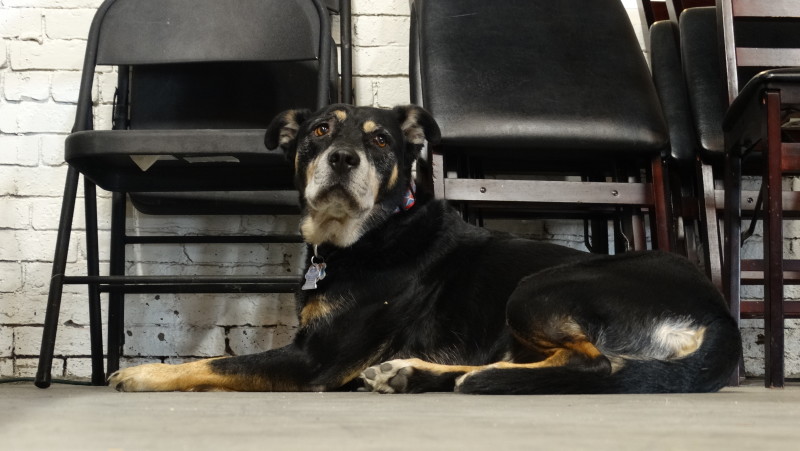
Beneath the shambles of construction, the work continues and the spirits are progressing, yet there is a relaxed, laid back essence in the air.
Matt provides a quick tour of the distilling space, where we see Adrian, the copper still (yes, they named it). The smells are overwhelming as the team works on the Angelica Liqueur, part of GrandTen’s small batch of naturally flavored cordials. The intoxicating smell of herbaceous clove, cinnamon and juniper fill the air. Good thing Matt is quick to offer us a cocktail.
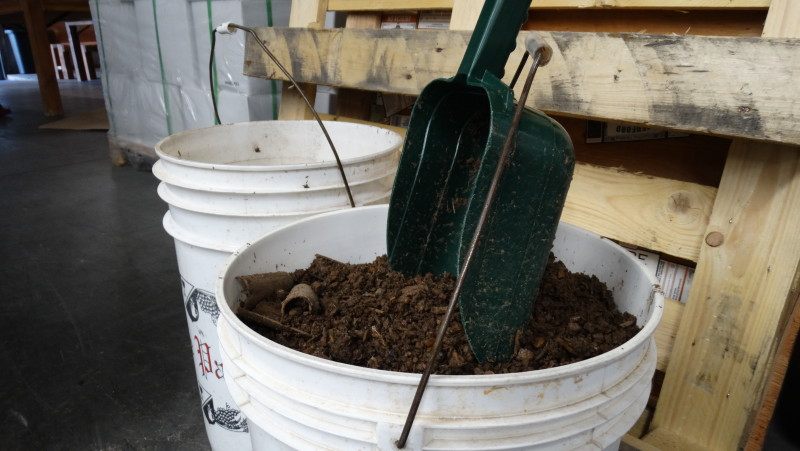
As Matt effortlessly mixes up a delicious Bees Knees of honey simple syrup, lemon juice, and GTD’s Wire Works American Gin, we chat about the road to renovation, which according to Matt has been a “long time coming” and is the natural next step for the company, which launched an Indiegogo campaign to raise funding last spring. After raising some money and getting the permits that will allow the renovations and the ability to open a bar that sells GTD cocktails to the public, the journey began.
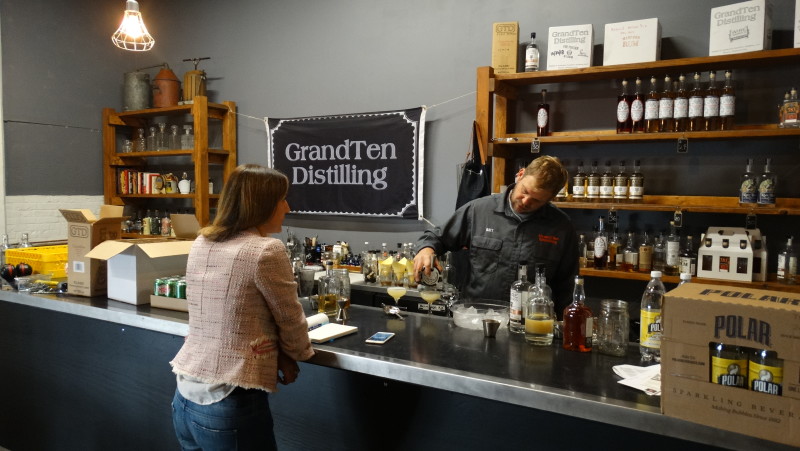
But let’s go back to the beginning…
As a Mechanical Engineer working in the software world, Matt decided he was ready to dive back into entrepreneurship in 2008 and applied to Babson’s MBA program, “in the summer of 2009, things were poor and internships were not plentiful,” recalls Matt. So, he spent the summer researching different opportunities.
“I asked myself, ‘if I could do anything, what would it be?’ and craft distilling was pretty appealing. There weren’t any craft distilleries in Boston at the time.”
Matt turned to his cousin, Spencer, who had just wrapped up his PHD in chemistry. That following summer, Spencer moved to Boston and “the rest is history.”
The two moved into the South Boston location and in April of 2012, started selling their first product: the signature Wire Works Gin, named for the wire the foundry space once produced.
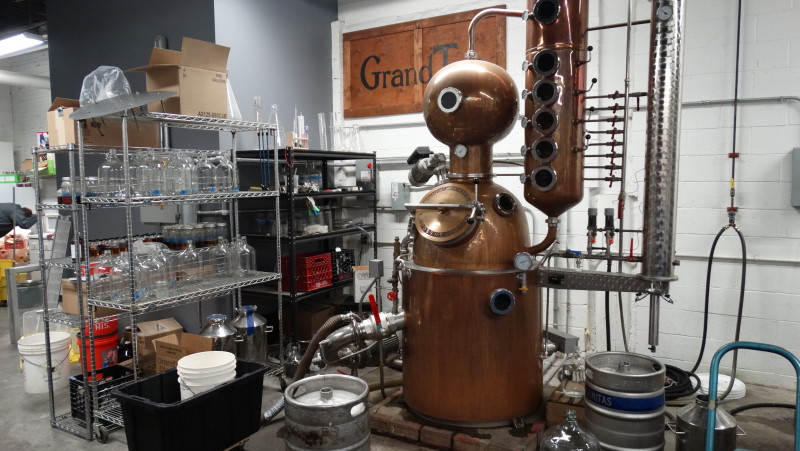
Highlight on GTD’s Fire Puncher Vodka
When I last visited GTD, I couldn’t resist purchasing a bottle of the Fire Puncher vodka, falling addicted to the chipotle smokiness that was unlike any other spirit I’d tasted. As with many of GTD’s products, there’s an interesting anecdote behind the name…
Matt excitedly tells the story of Tommy Maguire, who was the first to respond to a fire at the iron foundry in 1887. Before the South Boston Fire Department arrived, Maguire raised a ladder on his own, climbed the roof, and began punching the fire out with his bare fists. “The fire department arrived and dragged him off the roof where according to the Globe, he fought with the fierceness of a tiger,” says Matt.
“We thought anyone who was willing to fight fire with their fists deserves a spicy vodka named after him.”
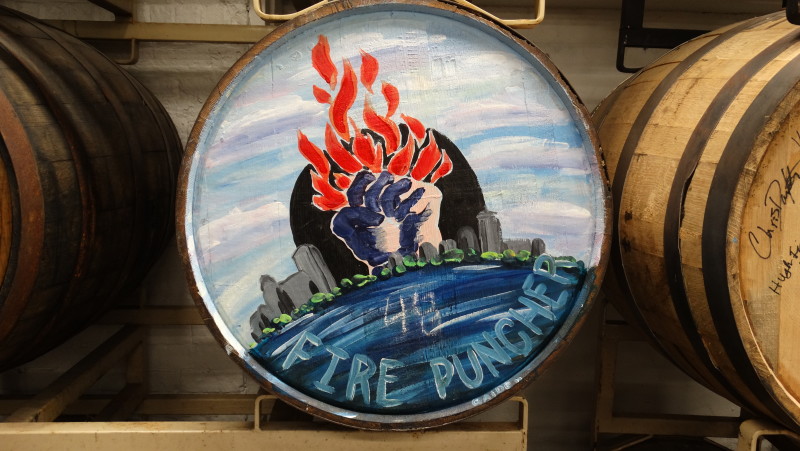
Having had this delicious spicy vodka in my freezer for quite some time, I was anxious to get Matt’s take on how to best drink a chipotle pepper infused vodka. Luckily he was filled with ideas, recommending to substitute it anywhere you’d use tequila, like a margarita, or what Matt calls a “Southie Mule,” mixing it with ginger beer and simple syrup. ““Fruit and Fire Puncher goes together really well, so don’t be afraid to experiment…and I think it’s time you finished that bottle.”
Duly noted. And I’m getting close on the latter. But my favorite suggestion? A spicy White Russian.
The Future of GrandTen
An anticipated opening for the new bar is right around the corner, aiming for the end of October. Friday Night Flights is still ongoing during construction, but Matt warns that he is uncertain of the future of the Friday event once the bar is open to the public. So the biggest piece of advice I can give is to get over there quickly for this great tasting event, and then keep an eye out for the bar’s opening. We’ll be sure to keep you posted.


